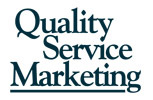Here’s the continuation of my interview with Chris Brown, MarketCulture Strategies.
QSM: Cross-functional collaboration and support are also necessary for employee engagement. Do you find the lack of collaboration in companies is related more to the organizational structure itself, especially those with entrenched silos? Or is it with problems related to internal communications – lack of management communications training, internal politics that impede information sharing, etc.?
Chris: Poor internal collaboration results directly from poor organizational structures: rigid groupings, polarizing reward systems, competing interests, etc. Employees work and live within these structures. Their behaviors reflect them, not the other way around. It is management’s job to build and shape these structures in a way that creates adequate collaboration.
For example, W. L. Gore, the maker of GoreTex™ fabric and other specialized materials, has largely done away with formal structures. It’s one of the 200 largest private firms in the U.S., but outside the c-suite, employees do not have official titles. Work sites are kept small, below 200 employees. In lieu of formal structures, employees build informal relationship lattices to get work done across the organization. It’s a lot of work, especially for leadership, but it results in rampant collaboration by employees. To borrow a line from the “Field of Dreams”, if you build it, it (collaboration) will come.
QSM: What are some creative approaches to improving internal collaboration?
Chris: It’s a mixture of informal and collaborative structures. For example:
- Creating cross-functional meeting structures that require regular interaction
- Rotating employees for short periods of time to allow them to live in the other “silo”
- Mixing functions and groups during breaks, lunches, and in the workplace layout
- Engineering cross-functional/cross-group interdependence into reward and evaluation systems
- Group newsletters/circulars/blogs.
Collaboration like everything else needs to be designed on purpose. It is up to the leadership to work out how to create the right conditions for it to flourish.
QSM: These are great ideas, Chris. Thanks for taking the time to share a bit of your expertise with us!




 In some organizations, management seems to have a limitedattention span as it follows a strategy-du-jour. In some nonprofits, the situation may also stem from initiatives that seem to take on a life of their own, in which management continues to automatically sink resources in such programs/events/activities without stepping back to address “Why are we doing this? Is it still relevant to our mission and our market?”
In some organizations, management seems to have a limitedattention span as it follows a strategy-du-jour. In some nonprofits, the situation may also stem from initiatives that seem to take on a life of their own, in which management continues to automatically sink resources in such programs/events/activities without stepping back to address “Why are we doing this? Is it still relevant to our mission and our market?” LISTEN and take into account employee ideas and concerns: Do employees clearly understand our new direction and the rationale behind it? What ideas/suggestions do our employees have to effectively execute the new plan(s)?
LISTEN and take into account employee ideas and concerns: Do employees clearly understand our new direction and the rationale behind it? What ideas/suggestions do our employees have to effectively execute the new plan(s)?